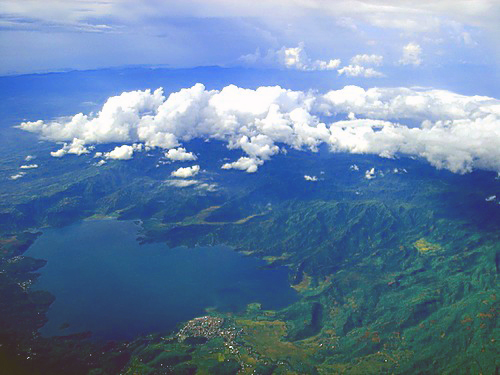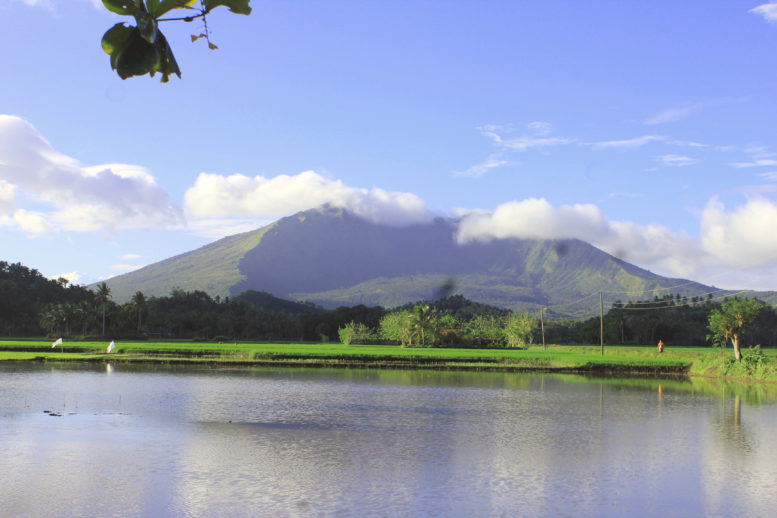The Bicol Peninsula is rich in natural resources and is a region known for its scenic destinations. The most famous lake in the Bicol region is Lake Buhi for its serene panorama. It is a 1,800 hectare freshwater lake, 8 meters deep, created out of volcanic activity, and is located in the town of Buhi, Camarines Sur. The lake derived its name from the local dialect “Naka-Buhi” meaning the town settlers were able to flee from the eruption of Mayon Volcano hundreds of years ago. Fresh water Lake Buhi is located between two old volcanos, Mount Iriga, which is also known as Mount Asog, and Mount Malinao.
Mount Iriga is an active volcano located about one kilometer from Lake Buhi, and its peak is forested with pine trees. It erupted in 1628 and in 1642, and is known for its Phreatic Explosions, which occurs when magma heats ground or surface water. Mount Malinao, located in Alinao, Albay is now probably an extinct volcano. It has no recorded eruption but exhibits intense Fumarolic Activity which is controlled and used for generating electricity. A Fumarole is defined as a hole in a volcanic region from which hot gasses and vapors issue.
Mount Malinao ranks second of the three most famous mountains of Albay, known as the “Magayon Trio.” Mount Malinao is famous for its beautiful Vera Waterfalls found at its slopes. Mount Masaraga is famous for being adjacent and closest to the perfect cone of Mount Mayon.
On 11-July-2018 Philippine’s Insider Magazine cited two theories of how Lake Buhi was formed. The first is when Mount Iriga’s side collapsed due to an earthquake in 1641. A landslide resulted creating a natural dam in which Lake Buhi came about. The second theory is when Mount Iriga erupted which created the beautiful Lake Buhi.
Lake Buhi is rich in marine life. Sinarapan (Mistichthys luzonensis) is one of 7 fish species endemic to Lake Buhi. It is the world’s smallest commercial fish. The other endemic fish: Irin-Irin (Redigobius Bikolanus), Dalag (Snakehead murrel; Chanda Striata), Puyo (Climbing perch; Anaya’s Testudineus), Kotnag (Hemiramphus), and Burirawan (Strophidon Sathete).
The surrounding forest of Lake Buhi is home to no less than 25 bird species, 5 of which are endemic to Lake Buhi: Black-Naped Monarch, Philippine Pygmy Woodpecker, White-Eared Brown Dove, Elegant Tit, Philippine Hanging Parrot. Other fauna living in the forest: Philippine Cynomolgus Monkey (Macaca fasicularis), Flying Lizards (Draco), Skinks, Monitor Lizards (Varanus marmoratus), Civets, and Bats.
Tabyos (Dwarf Goby; Pandaka Pgymea), world’s smallest fish, can be found in the Philippines. It is inedible, and toxic. This species is not to be confused with the Sinarapan (Black-spotted Goby; Mistichthys luzonensis) fish of Lake Buhi.
The fishing industry thrives in the town of Buhi due to the endemic fish of Lake Buhi and its surrounding lakelets. And there are 14 tributaries that converge into Lake Buhi. The most important lakelet is Manapao where a small sanctuary and repopulation project for Sinarapan is being undertaken. Due to the declining population of this endemic fish, the municipality has banned fishing of Sinarapan until its population stabilizes.
On 11-July-2018 Philippine’s Guide Magazine reports that Lake Buhi is the main source of livelihood for the residents of Buhi, Camarines Sur. Apart from the fishing industry, a hydroelectric plant of the National Power Corporation gets its water supply from Lake Buhi, and generates about 2.8 megawatts of power. The National Irrigation Administration also uses water from Lake Buhi to irrigate farms and rice fields in the Rinconada towns including Irriga City, and the Municipality of Pili, altogether covering over 12,000 hectares.
Four main fish species have been introduced into the lake to boost Inland Fisheries volume and value: Nile Tilapia (Oreochromis niloticus), Mozambique Tilapia (Oreochromis mossambicus), Karpa (Cyprinus carpio), and Bangkok Hito (Catfish). Freshwater fish cages of Tilapia surround Lake Buhi.
Marlowe Aquino, PhD, states in the Bureau of Agricultural Research (2018) that Lake Buhi is a source for raw materials for a new community livelihood. The Water Hyacinth, commonly called “Water Lily,” can be processed into handicrafts and is now a source of livelihood for people living along the lake’s adjacent barangays. The Water Lily has been transformed into a material source for a profitable enterprise through people’s initiative.

Lake Buhi at the bottom of Mount Iriga. Photo: Pauzflickz
Majestic Lake Buhi is one of the most famous lakes in the Philippines. Government representatives of the Bicol Region should aim at protecting the waters of Lake Buhi from fish feeds that only add to the polluted water; conserving its surrounding forest; and developing a sustainable tourist destination.
